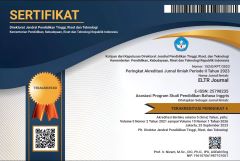THE TENTH GRADERS’ PERCEPTIONS ABOUT COLLABORATIVE LEARNING TO IMPROVE ENGLISH SPEAKING SKILLS
Abstrak terlihat: 716 / PDF terunduh: 642DOI:
https://doi.org/10.37147/eltr.v3i1.57Keywords:
Collaborative learning, perceptions, speaking skills, senior high schoolAbstract
Collaborative learning is a method where students learn by working together to achieve a task or goal. The implementation of this method can be maximized by using games. This study aims to find out how collaborative learning with games influenced English speaking skills of the tenth-grader students, and what challenges were faced in doing collaborative learning games. The study was completed using a qualitative descriptive design and was conducted with 20 tenth-grade students at a private senior high school in Salatiga, Indonesia. To explore the students’ views on the use of the collaborative learning with games, all 20 students were asked to fill in a questionnaire and four selected students then completed a semi-structured interview. The data were then analyzed by thematic analysis. The findings revealed a positive result from the students on the use of collaborative learning activities. The study also provides some pedagogical implications and suggestions for further investigations
Downloads
References
Abbaspour, F. (2016). Speaking competence and its components: A review of literature. International Journal of Research in Linguistics, 1,(4), 144-152.
Bisnoi, N. (2017). Collaborative learning: A learning tool advantages and disadvantages. Indian Journal of Health and Well-being. 8(8), 850-852.
Brown, F. A. (2008). Collaborative learning in the EAP classroom: Students’ perception. Retrieved March 20, 2018 from http://www.esp-world.info/Articles_17/issue_17.htm
Campbell, J., & Li, M. (2006). Asian students’ perceptions of group work and group assignments in a New Zealand tertiary institution. Proceedings of EDU-COM International Conference (pp. 78-89). Perth Western Australia: Edith Cowan University. Retrieved from http://ro.ecu.edu.au/ceducom/64
de Freitas, S. (2006). Learning in immersive worlds: A review of game-based learning. Retrieved April 7, 2018 from https://curve.coventry.ac.uk/open/file/aeedcd86-bc4c-40fe.pdf.
Dewi, R., Kultsum, U., & Armadi, A. (2016). Using communicative games in improving students’ speaking skills. Canadian Center of Science and Education, 10(1), 63-71. doi: 10.5539/elt.v10n1p63
Galletta, A. (2013). Mastering the semi-structured interview and beyond: From research design to analysis and publication. New York: NYU Press.
Gokhale, A. (1995). Collaborative learning enhances critical thinking. Journal of Technology Education, 7(1), 22-30.
Hedge, T. (2000). Teaching and learning in the language classroom. Oxford: Oxford University Press.
Ibrahim, N., Shak, M., Mohd, T., Ismail, N., Perumal, P., Zaidi, A., & Yasin, S. (2015). Procedia Economics and Finance 31, 346 – 353. doi: 10.1016/S2212-5671(15)01208-3
Yusof, M., Harun., Khariyah., Jamaludin., Abu., & Salleh. (2004). Cooperative learning in process dynamics and control course for undergraduates chemical engineering students. Proceedings of the Conference of Universiti Teknologi Malaysia skudai: 7th Triennial AEESEAP, Kuala lumpur, Malaysia. Retrieved from http://eprints.utm.my/id/eprint/948/
Laal, M., & Ghodsi, S. M. (2011). Benefits of collaborative learning. Procedia - Social and Behavioral Science. 31, 486 – 490. doi:10.1016/j.sbspro.2011.12.091
Le, H., Janssen, J., & Wubbels, T.(2018). Collaborative learning practices: teacher and student perceived obstacles to effective student collaboration. Cambridge Journal of Education,48(1), 103–122. Retrieved from https://www.tandfonline.com/doi/pdf/10.1080/0305764X.2016.1259389 DOI: https://doi.org/10.1080/0305764X.2016.1259389
Overtoom, C. (2001). Employability skills: An update. Retrieved February 20, 2018 from http://ww3.ericdigest.org
Pang, C., Lau, J., Poh, C., Chong, P.S., Cheong, L. and Low, A. (2018). Socially challenged collaborative learning of secondary school students in Singapore. Education Sciences. 8(24), pp.1-10. Retrieved from: https://files.eric.ed.gov/fulltext/EJ1174962.pdf DOI:10.3390/educsci8010024
Pattanpichet, F. (2011). The effects of using collaborative learning to enhance students’ English speaking achievement. Journal of College Teaching & Learning, 8(11), 1-10. Retrieved from https://eric.ed.gov/?id=EJ952409
Pratiwi, E. (2012). Improving the speaking skill of the tenth grade students at SMA Berbudi Yogyakarta by using videos in the academic year of 2011/2012. (Masters thesis, Universitas Negri Yogyakarta, Indonesia). Retrieved from http://eprints.uny.ac.id/25666/1/2007202244045.pdf
Petrovic, M. (2014). Games in the Language Classroom-To Play is to Learn. (Thesis, Malmö universitet, Sweden). Retrieved from http://muep.mau.se/bitstream/2043pdf
Peters, A. (2015). Use of games and game-like activities in teaching English to different age groups. World Scientific News, (7), 112-135. Retrieved August 12, 2018 from www.worldscientificnews.com
Rohmah, Z. (2012). Teaching English Joyfully. Malang: Bintang Sejahtera Press.
Spratt, M., Pulverness, A., & Williams, M. (2011). The TKT Teaching Knowledge Test Course Modules 1, 2, and 3. (2nd Ed). Cambridge: Cambridge University Press.
Torky, S. (2006). The effectiveness of a task-based instruction program in developing the English language speaking skills of secondary stage students. (Doctoral thesis, Ain Shams University, Cairo, Egypt). Retrieved from https://eric.ed.gov/?id=ED52392
Downloads
Published
How to Cite
Issue
Section
License
Copyright (c) 2019 Listyani Listyani

This work is licensed under a Creative Commons Attribution-ShareAlike 4.0 International License.













